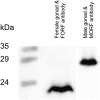Comparative mitochondrial genomics of freshwater mussels (Bivalvia: Unionoida) with doubly uniparental inheritance of mtDNA: gender-specific open reading frames and putative origins of replication
- PMID: 19822725
- PMCID: PMC2787441
- DOI: 10.1534/genetics.109.110700
Comparative mitochondrial genomics of freshwater mussels (Bivalvia: Unionoida) with doubly uniparental inheritance of mtDNA: gender-specific open reading frames and putative origins of replication
Abstract
Doubly uniparental inheritance (DUI) of mitochondrial DNA in marine mussels (Mytiloida), freshwater mussels (Unionoida), and marine clams (Veneroida) is the only known exception to the general rule of strict maternal transmission of mtDNA in animals. DUI is characterized by the presence of gender-associated mitochondrial DNA lineages that are inherited through males (male-transmitted or M types) or females (female-transmitted or F types), respectively. This unusual system constitutes an excellent model for studying basic aspects of mitochondrial DNA inheritance and the evolution of mtDNA genomes in general. Here we compare published mitochondrial genomes of unionoid bivalve species with DUI, with an emphasis on characterizing unassigned regions, to identify regions of the F and M mtDNA genomes that could (i) play a role in replication or transcription of the mtDNA molecule and/or (ii) determine whether a genome will be transmitted via the female or the male gamete. Our results reveal the presence of one F-specific and one M-specific open reading frames (ORFs), and we hypothesize that they play a role in the transmission and/or gender-specific adaptive functions of the M and F mtDNA genomes in unionoid bivalves. Three major unassigned regions shared among all F and M unionoid genomes have also been identified, and our results indicate that (i) two of them are potential heavy-strand control regions (O(H)) for regulating replication and/or transcription and that (ii) multiple and potentially bidirectional light-strand origins of replication (O(L)) are present in unionoid F and M mitochondrial genomes. We propose that unassigned regions are the most promising candidate sequences in which to find regulatory and/or gender-specific sequences that could determine whether a mitochondrial genome will be maternally or paternally transmitted.
Figures




References
-
- Akasaki, T., M. Nikaido, K. Tsuchiya, S. Segawa, M. Hasegawa et al., 2006. Extensive mitochondrial gene arrangements in coleoid Cephalopoda and their phylogenetic implications. Mol. Phylogenet. Evol. 38 648–658. - PubMed
-
- Betley, J. N., M. C. Frith, J. H. Graber, S. Choo and J. O. Deshler, 2002. A ubiquitous and conserved signal for RNA localization in chordates. Curr. Biol. 12 1756–1761. - PubMed
Publication types
MeSH terms
Substances
LinkOut - more resources
Full Text Sources

